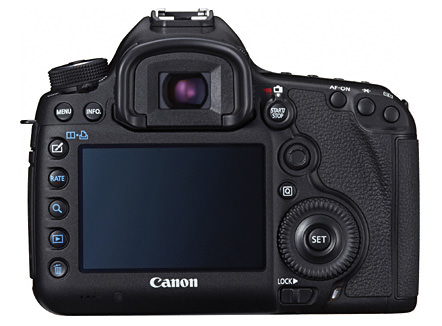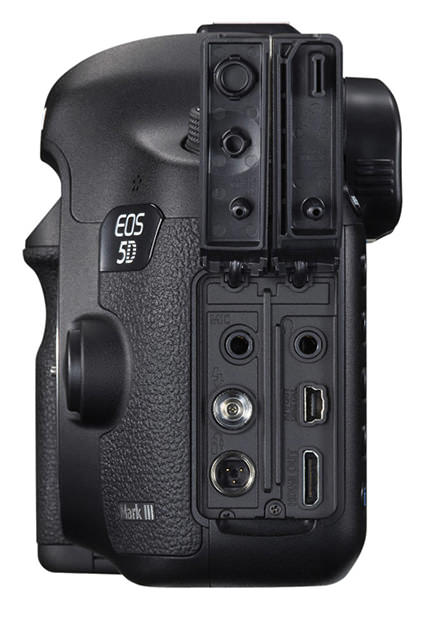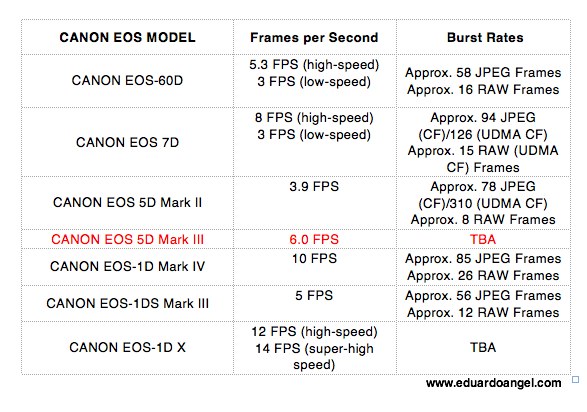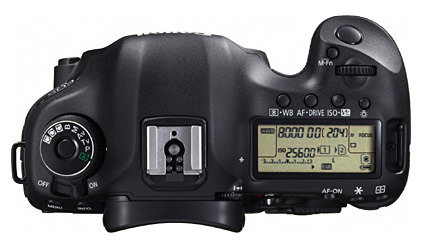Video
Canon EOS 5D Mk III, 5D3, 5D Mark III has arrived.
Ok. Let’s start from the beginning: We are looking at a 22.3 Megapixels, Full Frame (36 x 24mm) CMOS sensor system, powered by a DIGIC 5+ processor. Check this article if you want to fully understand the differences between the DIGIC 4 processor on the 5D Mark II, and the new DIGIC 5+ on the 5D Mark III.
Some of the highlighted features include:
• Dual card slots (1 SD/SDHC/SDXC and 1 CF). Sorry, no XQD on this one. What is awesome about the dual cards is that you can a) record the same data to both cards, or b) record different file sizes or types to each card, or c) automatically switch to the second card when the first card is full. That’s great when shooting long interviews, or concerts, for example.
• HDR with +/- 3 stops
• Improvement in noise reduction by 2 stops
• Multiple exposure mode
• 63 zone dual metering system
• +/- 5 stops (the 5D Mark II has only 3 stops)
• iFCL metering system with a 63-zone dual-layer sensor
• File Formats: AVI, RAW, JPEG, H.264, MOV, MPEG-4
• Full HD video recording: 1080/30p, 24p, 25p; 720/60p, 50p; 480/60p, 50p
All the typical features are here: Minimum Shutter Speed (30 sec), Maximum Shutter Speed (1/8000 sec), 100% coverage viewfinder, etc, etc, etc. As expected, durability on the Magnesium Alloy chassis has been improved including a 150,000-cycles shutter, and water and dust additional resistance.
These are the specs that REALLY got my attention:
• It is now possible to check two images side-by-side for sharpness, exposure, etc at different aspect ratios (1:1, 4:3, 16:9) with the new “Comparative Playback” function.
• There’s a Q button that will process RAW to JPG on camera.
• The new camera shares the same exact 61-point High Density Reticular AF system found in the EOS 1D-X (for half the price).
• There’s an iPod-like button to make changes in the movie mode without adding noise to the clips. Smart!

• The 5D Mark III uses the same batteries (LP-E6) as the 7D and 60D.
• The ISO war keeps getting better. The Mark III offers ISO 100-25600 (expandable up to ISO 102,400) for stills, and 100-12800 (up to ISO 25,600) for video. Wow! Now we really could use an iPad as a Key Light!
Here’s an interesting set of high-res JPEGs samples shot at ISO 50 to 102,800. The test was performed under low level halogen lights, which are perhaps the most challenging to digital sensors and noise reduction systems.
Video Features.
There are several serious improvements on this front:
•There are a couple of new video Modes: “Silent and Low Vibration,” but I don’t recall seeing them on the prototype I tested.
• The video resolution is Full HD (1920×1080), and the video format is the same H.264, which I personally love because it runs natively on Adobe Premiere Pro and Lightroom 4, and plays extremely well with online sharing platforms like Vimeo and YouTube.
• The recording buffer has been extended from 12 minutes to 29 minutes and 59 seconds. The 4GB limit is finally over.
• Following Nikon’s D800 improvement, we now have a 3.5mm headphone jack for live audio monitoring and a Wind Filter. Other ports include USB 2, HDMI, Mic Input, and Wireless.

• The LCD screen is virtually the same 3.2″ 1.04 million as the Nikon’s D800. With a screen this size photographers are out of excuses for not using Histograms the way they should.
• There’s a built-in info menu while shooting video, which comes super handy to quickly check important settings like White Balance, Resolution, ISO, Picture Style, etc.
Regarding audio, the changes are pretty exciting:
“The camera includes manual audio level control with 64 levels, adjustable both before and during movie recording. There is also an automatic audio level setting, or sound recording can be turned off entirely. A wind filter is also included. Sound can be recorded either through the internal monaural microphone or via an optional external microphone through the stereo mic input.”
—Click to continue
“The EOS 5D Mark III includes new H.264 video compression formats to simplify and speed up post-production work: intraframe (ALL-I) compression for an editing-friendly format and interframe (IPB) compression for superior data storage efficiency, giving professionals options to help achieve their ideal workflow. Like the EOS-1D X, the 5D Mark III also includes two methods of SMPTE-compliant timecode embedding, Rec Run and Free Run, allowing video footage from multiple cameras and separate audio recordings to be synced together in post production.”
The new camera delivers 6 frames per second at high-speed. Burst Rate and Frames per Second (fps) speeds, are NOT the same – shooting speed, or fps, dictates the speed at which you can take consecutive shots; Burst Rate dictates how many of those shots you can take in a continuous burst, without slowing down. We put together this chart to compare the most current Canon EOS systems side-by-side:
 New Accessories:
New Accessories:
Several new accessories will be added to Canon line of toys. There’s a new flash, the Speedlite 600EX-RT, which is 20% faster than the 580 EX II, and comes with built-in wireless radio control (up to 16 channels in 5 groups). We have a new Wireless File Transmitter WFT-E7A supporting 802.11 a/b/g/n, and a built-in gigabit Ethernet connection. And soon we will also have a new GPS device (GP-E2), which will be the perfect companion to Adobe Lightroom 4 brand new Map Module.
Here’s a hands-on test with the 600EX-RT Flash and the STE3-RT Transmitter.
 The 5D Mark III will start shipping by the end of this month for $3,500 (body only) and for $4,300 with the 24-105mm f/4 L IS lens.
The 5D Mark III will start shipping by the end of this month for $3,500 (body only) and for $4,300 with the 24-105mm f/4 L IS lens.
So, is this the camera of your wildest dreams? Canon shooters: Are you planning to upgrade to the 5D Mark III or are you considering the EOS C300?
Feel free to share your comments below.


